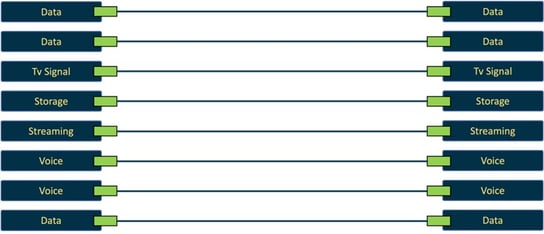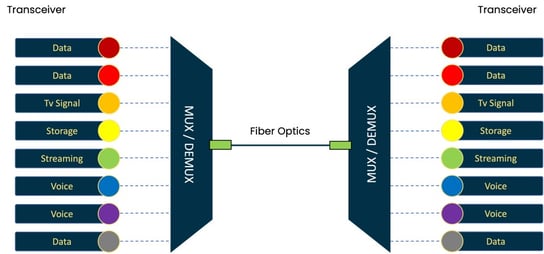WDM Multiplexing in Telecommunications Networks: All You Need to Know

Fiber optic networks are and have always been the fastest and most efficient means of transporting large amounts of information between two points. These networks have been around for some time now and have been in use for several years.
Initially, it was thought that a fiber optic channel would have unlimited capacity; however, it was soon realized that each fiber optic is a precious and limited transmission channel. With the increasing demand for information, it was necessary to increase the capacity of fiber optic networks, and this could be done in two ways: by increasing individual fiber channels or by introducing multiple wavelengths in a single transmission channel.
Wavelength division multiplexing (WDM) was the solution found to introduce several virtual communication channels in the same physical transmission channel, which is the fiber optic. In other words, each wavelength can carry a signal of 10Gb/s, and if four different wavelength channels, each carrying 10Gbs/s, are introduced, that fiber optic can then have a transmission capacity of 40Gb/s - which is a high transmission capacity.
With the current demand for data and the need for information transmission, WDM multiplexing is becoming an increasingly used system, to respond to the need of increased transmission capacity without having to increase the number of cables installed.
Basics of WDM Multiplexing
WDM Multiplexing consists in the generation of multiple virtual transmission channels through the creation of specific wavelengths, which are introduced through a multiplexer (MUX) into a single optical fiber, that are then transmitted along this fiber. At the other end of the fiber, there is a demultiplexer that will divide the various channels from one optical fiber into several optical fibers, which are then routed to their respective receivers.

Transmission in individual fiber channels

Multiplexing of different signals into one fiber channel
Basically, it works like a splitter, where there is an aggregation of several channels into one and then, at the other end, the disaggregation of one channel into several.
There are two types of WDM Multiplexing: are the Coarse WDM (CWDM) and Dense WDM (DWDM); which we’ll talk more about later in this article.
WDM Components
A WDM multiplexing system is, essentially, a fiber optic network in which there is an emitting transceiver, a receiving transceiver, a wavelength multiplexer, a wavelength demultiplexer and the network itself.
The transceivers, also called SFP (small form pluggable), are the components that convert data electric signals to optical signals, that can be transmitted into the fiber. On the other end, the receiving transceivers will, then, convert the optical signals to electric signal. The transceivers are always wavelength-specific in any fiber optic network. For the WDM multiplexing, these transceivers are named “colored” transceivers.
Every transceiver, or SFP, has one defined transmitting wavelength, or color. Each of these colors will be aggregated into one fiber optic channel by the WDM Multiplexer. Due to the physical properties of light, the different wavelengths do not interfere with each other, so every wavelength is a virtual transmitting channel within one real physical channel. On the other end, the Demultiplexer will divide the different wavelengths to each specific channel and then connect to each specific transceiver.
.png?width=298&height=195&name=box_MTB-series-removebg-preview%20(1).png)
Example of Bi-directional transceiver
It is important to note that the multiplexer and demultiplexer are wavelength dependent. Each wavelength will enter and exit on that specific channel. The multiplexer/demultiplexer are devices with wavelength-specific filters that will only let pass that specific wavelength and reject all others.
Types of WDM Multiplexing
As explained before, there are two types of WDM multiplexing: Coarse WDM (CWDM) and Dense WDM (DWDM).
Coarse WDM (CWDM)
Coarse Wavelength Division Multiplexing is a type of WDM Multiplexing where the wavelengths have a separation of about 20 nanometers between them, and that can carry up 18 channels. This requires less precise laser sources, which makes it more affordable.
By being less precise and having a larger separation between wavelengths, less virtual channels can be introduced in the same physical channel, since singlemode fibers work between 1260nm and 1650nm.
Dense WDM (DWDM)
With Dense Wavelength Division Multiplexing, the separation between wavelengths is only 0.8 nanometers. which allows to introduce up to 80 channels of communication within the spectrum of the transmission of singlemode fibers
To be able to do so, DWDM requires highly precise laser multiplexing, which are consequently more expensive. However, with this type of WDM multiplexing, more transmission channels can be introduced in a single optical fiber and, therefore, transmit much more information.
Applications of WDM Multiplexing
WDM multiplexing were initially used mainly for backhaul transmission networks which transport large amounts of information and needing to use the least number of resources (fibers).
With the proliferation of optical fibers, the use of WDM multiplexing became more common, being utilized in point-to-point connections such as to connect mobile base stations or Datacenters.
The WDM principle is also used in access networks such as FTTH, using GPON technology, in which several wavelengths travel inside one optical channel to enable customer connection. With the introduction of XGS-PON technology, more wavelengths will be added to these networks.
In some cases, the network may have additional sites needing connection between the two endpoints. In these cases, an OADM (Optical Add-Drop Multiplexer) can be used to extract a specific wavelength for that site. This allows the construction of much more versatile access networks.
Future of WDM Multiplexing
With the development of technologies, especially 5G, and with a society where everything is always connected, WDM multiplexing tend to become more and more widespread.
WDM Multiplexing have a big role in the ability of telecommunications networks to meet the growing demand for high-speed data. These multiplexing allow the introduction of multiple wavelengths in a single transmission channel, which increases the capacity of fiber optic networks without increasing the number of fibers installed.
Either through CWDM or DWDM, or with the utilization of OADMs, WDM multiplexing can be applied in many contexts where transmission and transport of information is needed and provides various advantages to fiber optic networks.


